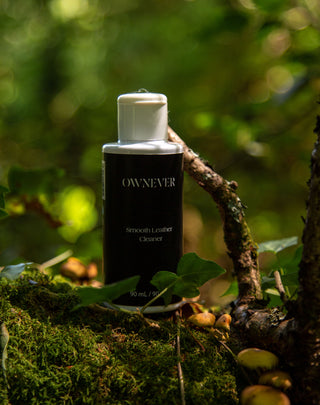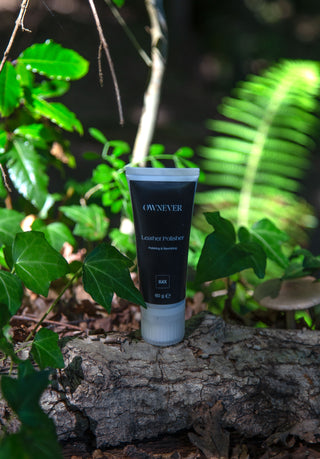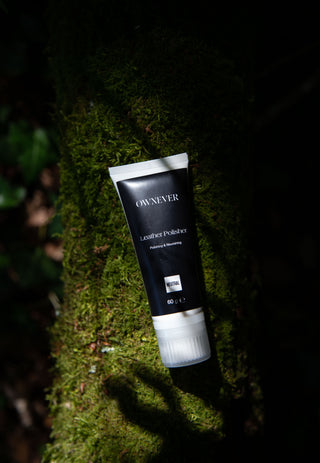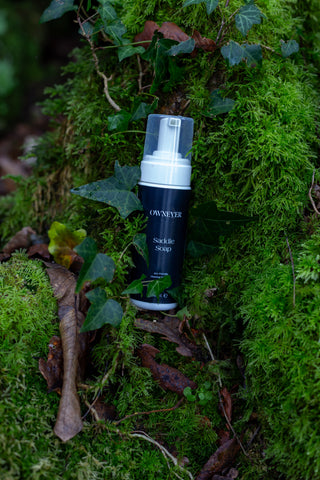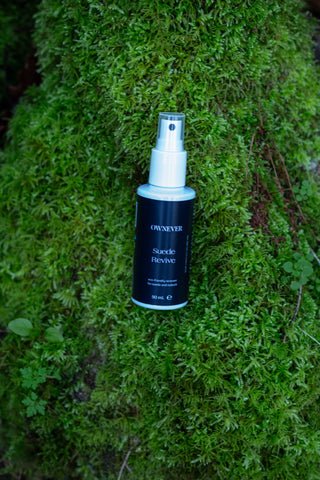Currently, there are several good practices under the designation of "circular fashion," but it is necessary to apply them on a large scale to limit the immense damage caused by the current overproduction. When talking about circular fashion, this concept refers to a closed system in which resources are not discarded after use but are reintegrated into the life cycle. For example, circularity in fashion occurs when we extend the life of clothes and accessories by repairing, reselling, or transforming them through upcycling processes.
Recycling the fibers that make up clothing is also a good practice in the circular perspective, but to be truly efficient, this option must be considered in the product design phase. The same applies to leather accessories, where 2 million kilograms of hazardous leather waste are generated each year due to the footwear industry.
What is circular fashion
The concept of circular fashion may not be immediately obvious, but if we use a visual reference, it would be a circle as opposed to a straight line. Circularity is a system that operates in a closed cycle, as opposed to a unidirectional or linear system. The linear system, to which we are more accustomed, involves extracting resources from the earth, turning them into products, using them, and then discarding them. This approach treats resources as infinite; once discarded, their value is completely lost. Circular economy proposes that instead of discarding something when we are done using it, we reintegrate it into the system, either completely or in a way that its materials are reused in some form. Such a system is regenerative and reparative: applying circular system principles across all industries could not only reduce pollution but also create value. But what does circularity mean in the fashion industry? Creating circularity in fashion involves creating a system that operates in a closed cycle, reusing resources instead of discarding them after use or bringing new ones into the circuit.
Advantages of circular fashion
With over 100 billion pieces of clothing produced each year and consumption set to increase by 63% by 2030, maintaining the current growth pace of the fashion industry would triple the current consumption of already overused resources on the planet: remember that Overshoot Day, the day we exhaust resources for the current year, occurred on August 2, 2023, worldwide. The European footwear industry, which consumes the most leather, produces over 1 billion pairs of shoes per year, of which 70 percent have leather uppers. It is estimated that this process generates 100,000 tons of leather waste, most of which is discarded in landfills or incinerated.
In the fashion industry, only 13% of textile products are recycled since clothes are usually discarded. Most of them enter the second-hand market, but less than 1% is recycled into new clothing; the rest becomes textile waste, representing a loss of over 100 billion dollars in materials each year. Currently, there are basically two ways to approach circularity: on the one hand, keeping clothes and textile products in use for as long as possible; on the other hand, recycling clothes to obtain new fibers.
The first option includes activities that aim to extend the life of products, such as selling or repairing, and those that, from existing products, create something that did not exist before, i.e., upcycling. The second option includes all processes that can obtain new fibers from existing ones through recycling processes.
For a process to be truly circular and reduce its environmental impact, it is important that the pieces change hands without additional waste of resources, or that this waste is minimal, as in the case of resale shipments.
Repair
Repairing items, including shoes and bags, is certainly one of the most environmentally friendly methods to extend the life of products, but it is not always so simple. Of course, there is the maintenance of clothes that we can all adopt, taking care of them in household washes and intervening in products when they are worn or damaged, but often the necessary repairs exceed what we can do alone. In the case of leather bags and accessories, hydration, cleaning, and good practices to keep them in good condition for longer apply, and in certain cases, repairs should be done by professionals who know how to do them properly. Fortunately, many brands have initiatives related to repair, especially in the outdoor sector, a world where the performance of products is directly linked to their operational status. For example, the North Face has had a dedicated repair department since 1971 and recently launched the TNF Renewed program, an initiative that renews consumers' items that they no longer use in exchange for a discount. Patagonia took repair worldwide with the Worn Wear Tour, going to mountainous areas and offering repairs for outdoor pieces, while since last November, the California brand has opened fixed repair stations in its own stores. Ownever creates bags to be repairable, where the components are detachable and more easily repairable, going further and repairing bags from other brands that need it.
Resale
A reflection of the consumerist society we are immersed in is that we inevitably end up buying more than we need: this happens with everything, including clothes and accessories, which often end up being used very little. In this scenario, the importance of practices such as reselling unused items comes into play. A practice that is exponentially easier today than in the past and, above all, much more widespread thanks to the proliferation of second-hand resale apps. By 2026, the turnover of the second-hand market is expected to reach $82 billion, with a 275% growth compared to pre-pandemic volumes. This significant increase is partly justified by technology, which has made buying and selling second-hand clothes and accessories more immediate, but also by a shift in consumer perspective, driven by economic factors and a growing awareness of environmental issues, buying and, especially, selling through online marketplaces.
Upcycling and creative transformation
Another excellent approach to circularity to reintegrate used clothes and accessories is through upcycling. This creative process seeks to create value from what would normally be considered waste. Transforming fabric scraps from pants or a coat into something new is an example of this process. The result can be similar to the original product, as in the case of jeans made from other jeans, or a complete functional transformation, resulting in something completely different. Upcycling represents an innovative and creative way to reuse materials.
Textile and Leather recycling
The challenges of recycling textile fibers are a complex task. The recycling process itself consumes energy, and the diverse composition of clothes makes the process even more complex. Ideally, monomaterial products would be the solution, but research is advancing in this area. Companies like Osomtex use technology to recycle textile waste into new yarns, while Evrnu converts textile materials into new fibers with its patented chemical process allowing repeated recycling. However, mixed textiles, made of different fibers, are difficult to recycle due to their chemical compositions and distinct melting points. Although technological advances may enable future recycling, it is currently preferable to choose pure textiles that are more easily recyclable. Contamination, such as oil stains, and the presence of mold are major challenges for textile recycling. Ornate textiles, with sequins or beads, are generally non-recyclable due to the complexity of their composition and the high cost of manual removal. These embellishments can be made from non-recyclable materials.
Circular economy beyond materials
The application of circularity is not limited to materials alone. Industrial processes can generate additional value by converting by-products into energy or identifying disposable products that can be utilized by other industries. Harnessing steam from certain processes to generate energy and the reuse of wastewater and chemicals are very promising practices in this context. Innovative companies, such as Reda 1865, a wool yarn producer, collect and provide the pharmaceutical industry with lanolin, a protective fat found in wool and a byproduct in raw wool washing processes.
For example, solid waste generated by the leather processing industry poses a significant challenge. Tanneries, trimmings, which are the main solid waste from a tannery, undergo a process to generate biogas. This process involves biologically liquefying the trimmings completely. The resulting liquefied trimmings are treated in anaerobic reactors, and this transformation process produces biogas, a source of renewable and sustainable energy that helps reduce the use of fossil fuels and, consequently, decrease CO2 emissions.
Revolutionary legislative changes loom over the clothing and footwear industry
In 2020, the European Commission launched a Circular Economy Action Plan with the aim of making sustainable products the norm in the EU, supporting the EU's carbon neutrality goal by 2050, and promoting sustainable growth. The European Commission highlighted the textile sector, along with four others, as one with the greatest environmental impact and less sustainability.
In practice, this means that the European Commission will implement a series of regulations that will affect how this industry conceives, produces, markets, and discards its products. Some of these regulations will be implemented in the coming years, and their impact can be very significant, something quite unprecedented. These EU legislative changes will alter the way products are designed. The Sustainable Products Initiative regulation is almost in force.
This regulation, considered the mother of all sustainability regulations, will impose requirements on how a product is designed, from minimum quality levels to the minimum content of recycled material. It will have a direct impact on what products are and will be. In addition to being fully integrated into the field of sustainability, the other key transformation for clothing, footwear, and bags will be digitization. This includes creating a digital twin for all items placed on the EU market, the Digital Product Passport, which will accelerate the flow of information between all different stakeholders, from manufacturers and brand consumers to governments.
Finally, this will change the way we think about the end of product life. By 2025, all waste in Europe must be collected and separated. To address this waste and turn it into resources, a package of regulations is being discussed, and many countries are developing EPR schemes to increase brands' and retailers' responsibility for the products they put on the market, support the implementation of new sorting and recycling infrastructure, and accelerate the transition to a more circular business model.
All these regulations will have a dramatic impact on operations throughout the entire value chain of clothing, footwear, and accessories, providing the means to truly bring about an efficient transformation.
Integration of circular fashion in design and sustainable future
Circularity in the fashion industry is not a utopia but requires comprehensive integration, usually starting in the design phase. Thinking about clothes, accessories, and collections with a circular approach, both in terms of materials and use, is crucial to meet demand, especially in Europe. The European Strategy for Sustainable and Circular Textiles emphasizes anticipating the fate of products at the end of their useful life. Implementing these guidelines by 2030 will require significant collaboration between industry and government, substantial investments, large-scale innovation, transparency, and traceability to achieve truly sustainable fashion.


